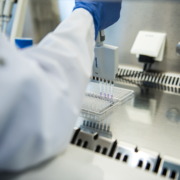Episode 32: How microbes and mucus interact in the gut

Podcast: Play in new window | Download
Subscribe: Apple Podcasts | Spotify | RSS
How microbes and mucus interact in the gut, With Dr. Mindy Engevik PhD
Episode summary:
In this episode, the ISAPP hosts discuss mucus-microbe interactions in the digestive tract with Dr. Mindy Engevik PhD from the Medical University of South Carolina, USA. They discuss how mucus in the gut is produced and degraded, and different ways that pathogens and commensal microbes interact with the mucus layer. Dr. Engevik describes some different ways that commensal bacteria make use of mucus, as well as dietary influences on gut mucus production.
Key topics from this episode:
- The gut epithelium has special cells called goblet cells that actively secrete mucus. In the small intestine, mucus forms a light barrier but in the colon, it forms a thicker barrier with two layers: an inner layer free of microbes, and an outer layer where mucus and microbes coexist.
- Bacteria in the gut make use of mucus in different ways. Many microbes have the capacity to degrade mucus, and it can provide a carbon source for bacteria to survive. Even bacterial quorum sensing can be influenced by mucus.
- Bifidobacteria increase mucus production. Akkermansia are good at degrading mucus and also increasing mucus production. Pathogens, however, degrade the mucus and cause inflammation so mucus production is suppressed.
- Several human diseases involve a dysfunctional gut mucus layer – for example, inflammatory bowel disease.
- Various models are used for studying mucus – for example, traditional cell lines and human intestinal organoids.
- Dr. Engevik’s work has found interactions between Clostridioides difficile and Fusobacterium nucleatum in the gut: these bacteria can interact to form biofilms that are more antibiotic-resistant than normal.
- Individual differences exist in gut microbes as well as glycan structure in the gut, so the best insights will likely come from understanding the entire network of microorganisms, metabolites, and mucus.
- Dietary components influence the gut microbiota, which influences mucus production in the gut. High dietary fiber increases the amount of mucus produced by the goblet cells. Some bacteria degrade dietary substrates, then switch over to mucus when they don’t get what they need from the diet.
- Dr. Engvik is an avid science communicator and advocates for scientists being present on social media. She has found science communication a great way to engage with the public as well as fostering scientific collaborations. The Instagram account showing microscopy images from her lab is @the_engevik_labs
Episode links:
- Bifidobacterium dentium Fortifies the Intestinal Mucus Layer via Autophagy and Calcium Signaling Pathways
- Characterizing the mucin-degrading capacity of the human gut microbiota
- Mucin-Degrading Microbes Release Monosaccharides That Chemoattract Clostridioides difficile and Facilitate Colonization of the Human Intestinal Mucus Layer
- Fusobacterium nucleatum Secretes Outer Membrane Vesicles and Promotes Intestinal Inflammation
About Dr. Mindy Engevik PhD:
Mindy Engevik is an Assistant Professor at the Medical University of South Carolina. She has Ph.D. in Systems Biology & Physiology and an interest in microbe-epithelial interactions in the gastrointestinal tract. Her lab focuses on how commensal friendly bacteria in the human gut interact with intestinal mucus and she tries to leverage this information to treat intestinal disorders. You can follow her on Twitter at @micromindy.






